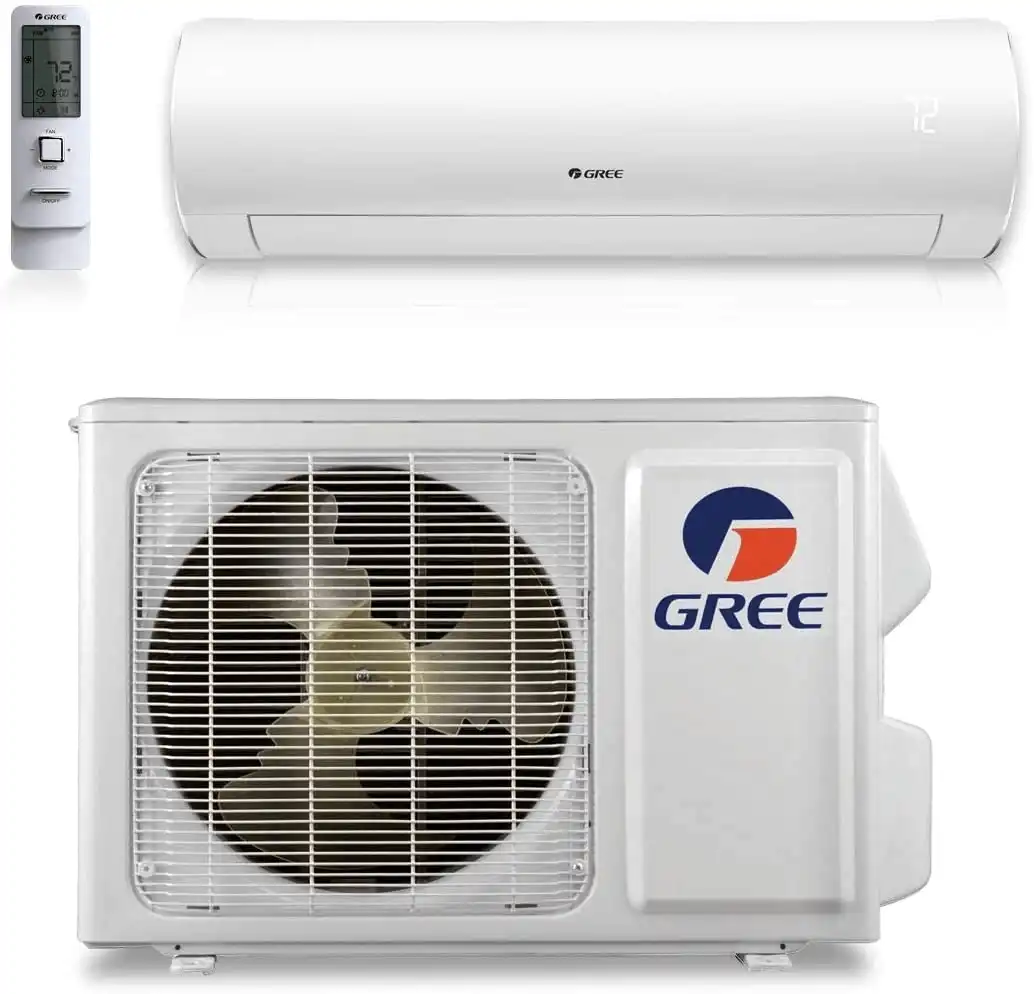
How Do Mini-Splits Work? Exploring the Science Behind Mini-Split Heat Pumps
Mini-splits are transforming how homeowners and businesses achieve comfortable indoor climates in all seasons. Unlike traditional furnaces or air conditioners that rely on extensive ductwork, mini-splits leverage heat transfer technology to move warmth in and out of a space more efficiently, without the need for combustion, which requires substantially more energy. This innovative approach provides year-round heating and cooling while delivering significant energy savings and superior temperature control.
In this article, we’ll explain how mini-splits work, highlight the fundamentals of heat pumps, and delve into some of GREE’s advanced mini-split features that place GREE at the forefront of heating and cooling systems. By the end, you’ll have a clear understanding of why ductless systems are a go-to choice for homeowners seeking cost-effective comfort.
What are the Components of a Mini-Split and Why are Mini-Splits More Efficient Than Traditional AC Systems?
A mini-split system is typically a ductless air conditioning system. Mini-splits have two main components—an outdoor unit, located on or near an exterior wall, and one (or more) indoor units, typically located on an interior wall, opposite the outdoor. Both units are often connected through a conduit, created through a small hole in the wall, which removes the need to send conditioned air through extensive ductwork.
The outdoor unit houses the compressor and condenser coil and features a fan that moves air across the condenser to either release or absorb heat as needed. In contrast, the indoor unit contains the evaporator coil, a fan, and an air filter. Mounted on a wall, ceiling, or floor, it directly distributes conditioned air throughout the space.
Mini-Split Efficiency: No (or Minimal) Ductwork, Less Heat Loss
Since mini-splits don’t rely on ductwork, you’ll avoid the 20–30% energy loss commonly associated with leaky or poorly insulated ducts that traditional HVAC systems experience. In addition, installation typically requires only a small opening in the wall or ceiling for the conduit—making it a favorite option for renovations, historic homes, or building expansions where running new ducts would be impractical.
The Efficiency of Independently Controlled Zones
Mini-splits offer the advantage of zoned heating and cooling. Unlike traditional systems that condition the entire space, mini-splits allow for individual rooms or zones to be controlled independently. This means you can heat or cool only the occupied spaces, avoiding energy waste in unoccupied areas. This targeted approach to climate control can lead to significant energy savings and improved comfort. Moreover, mini-splits offer a level of customization that traditional systems can't match, allowing different rooms or zones to be heated or cooled to specific temperatures based on individual preferences. The ability to control heating and cooling for zones independently leads to even greater efficiency and lower utility bills, as the system requires less energy to provide effective heating and cooling throughout the space.
The Power of Inverter Technology
GREE mini-splits utilize inverter technology to achieve optimal and consistent comfort. Unlike traditional HVAC systems that cycle on and off at full power, inverter-driven compressors can adjust their speed to precisely match the heating or cooling needs of a space. This means that when the temperature is mild, the compressor operates at a lower speed, using less energy. As the temperature changes, the compressor ramps up or down as needed, providing more or less heating or cooling power. This modulation eliminates the energy-intensive on-and-off cycling of traditional compressors, resulting in smoother operation and reduced energy consumption.
Single Zone Mini-Splits vs Multi-Zone Mini-Splits?
Single-zone mini-splits are designed for climate control in a single space. They consist of one outdoor unit and one indoor unit, providing heating and cooling to a specific room or area. This setup is ideal for “too cold” or “too hot” spots where you need additional air conditioning for a single room, such as a bedroom, sunroom, or a newly constructed addition to a home. Single-zone mini-splits also work great for renovated spaces such as basements, attics, garages, or even sheds.
Multi-zone mini-splits, on the other hand, offer greater flexibility by allowing you to control the climate in multiple spaces. These systems utilize one outdoor unit connected to multiple indoor units, with each indoor unit serving a separate zone. This means you can independently control the temperature in different rooms or areas of your home or building.
The key difference between single-zone and multi-zone mini-splits lies in their capacity to condition multiple spaces. Single-zone systems are limited to a single room or area, while multi-zone systems provide individualized climate control for multiple zones. This distinction makes multi-zone mini-splits a more versatile option for larger homes or spaces with varying temperature requirements.
Types of Mini-Split Indoor Units
When choosing a GREE mini-split, you have several indoor unit styles available to match your home’s layout and aesthetic:
- Wall-Mounted
- Typically installed high on a wall for maximum air circulation.
- Offers a sleek, modern look with straightforward installation.
- Floor-Mounted
- Sits closer to the ground, making it ideal for spaces without suitable wall or ceiling space.
- Can be partially recessed into a wall for a more discreet appearance.
- Ceiling Cassettes
- Mounted in the ceiling, often in a central location, for even air distribution.
- Very discreet, with only the grille visible in the finished ceiling.
- Console Units
- Floor-standing models that resemble a small radiator or console.
- Good for rooms with unique design constraints where wall or ceiling installation is impractical.
- Ducted Units
- Ducted units are an alternative to ductless indoor air handlers for specific applications where ductwork is beneficial. Ducted mini-split air handlers are particularly useful in scenarios where a low-profile or recessed indoor unit is desired, or when connecting multiple small rooms that are close together, such as two bathrooms.
- GREE’s ducted indoor air handlers are ideal for short duct runs, allowing for efficient heating and cooling in areas where traditional highwall units might be too large or impractical. This option provides flexibility for more complex installations while still leveraging the efficiency of mini-split technology.
Each indoor unit provides zoned control, giving you the flexibility to tailor the climate of each room or area independently.
What Is a Heat Pump and Why Does It Matter?
At the core of every mini-split is heat pump technology—a system designed to move heat rather than generate it. Here’s a closer look at why that makes all the difference:
Heat Transfer vs. Heat Generation
In cooling mode, a heat pump extracts heat from the indoor air and releases it outside, effectively lowering your home’s indoor temperature. When switched to heating mode, the process reverses—pulling available heat from the outdoor air and transferring it indoors. Because a heat pump simply transfers heat, instead of creating it through combustion, it’s able to provide temperature control using much less energy than traditional HVAC systems, typically leading to substantially lower utility bills for a home or business.
When you consider that a heat pump moves existing heat instead of creating it, the efficiency gains become clear—especially compared to traditional systems that burn fuel to generate warmth.
How Heat Transfer Works in a Mini-Split Heat Pump
As mentioned earlier, heat transfer is the process of moving heat from one location to another. In a heat pump, this means capturing heat from the outdoor air—even on chilly days—and delivering it indoors to provide warmth. The core of this technology is the refrigeration cycle, which relies on four key components: the evaporator, compressor, condenser, and expansion valve.
Mini-Split Heating Mode:
When operating in heating mode, the cycle begins in the outdoor unit. Here, the evaporator coil contains refrigerant that absorbs heat from the ambient air, causing the refrigerant to evaporate into a low-pressure gas. This gas is naturally drawn into the compressor, where its pressure and temperature are significantly increased. The now high-energy refrigerant flows into the indoor unit, where the condenser coil releases the stored heat into the indoor air. After releasing its heat, the refrigerant condenses back into a liquid and travels back to the outdoor unit through an expansion valve. This valve reduces the refrigerant’s pressure and temperature, preparing it to absorb more heat and continue the cycle. Even when outdoor temperatures drop, enough heat remains in the air for the system to extract and transfer indoors.
Mini-Split Cooling Mode:
During warmer months, the cycle reverses. The heat pump extracts heat from inside your home via the indoor evaporator coil. The refrigerant absorbs this heat and evaporates, then travels to the outdoor unit where the compressor raises its pressure and temperature. In the outdoor condenser coil, the refrigerant releases the absorbed heat to the outside air. This reversal of the cycle cools the indoor environment. A reversing valve typically enables the system to switch between heating and cooling modes seamlessly.
This dual functionality makes heat pumps a versatile and energy-efficient solution for year-round climate control, offering a sustainable alternative to traditional heating and cooling systems. Homeowners and businesses appreciate that, even in extreme temperatures, heat pumps can efficiently transfer heat, providing consistent comfort throughout the year.
GREE Mini-Splits: Advanced Features & Product Lines
GREE is a leading name in the ductless HVAC industry, offering a range of mini-split heat pumps equipped with advanced features. But what makes GREE mini-splits stand out from other brands?
- Contractor Support: GREE is always investing in new ways to support GREE certified contractors through educational platforms and advanced tools on our website like the GREE system builder. Not only does GREE offer live web-trainings, GREE is constantly recording new video content to educate contractors on the nuances of different installation projects and how to best service their clients.
- Energy Efficiency: GREE mini-splits are some of the most energy-efficient systems on the market. For example, the Sapphire model boasts a SEER rating of up to 38. GREE mini-splits also leverage inverter technology to adjust the compressor speed based on the cooling or heating demand, which can save you money on your energy bills.
- Quiet Operation: GREE mini-splits are designed to operate quietly, so you can enjoy a comfortable indoor environment without being disturbed by noise.
- Easy Installation: GREE mini-splits are easy to install. While many GREE mini-splits are ductless, providing for an even simpler installation, GREE also offers options for ducted systems for more complex installation projects.
- Environmentally Friendly Refrigerants: GREE mini-splits now offer mini-splits that leverage R32 refrigerant, which is an environmentally friendly option, free of forever chemicals you’ll see in some other refrigerants.
- Wi-Fi Connectivity: Many GREE mini-splits come with built-in Wi-Fi, allowing users to control their system remotely using your smartphone or tablet.
- GREE+ App: The GREE+ app provides smart temperature control, remote access, and compatibility with Amazon Alexa and Google Home for enhanced convenience and control.
Why Choose a Mini-Split Heat Pump System for Heating & Cooling?
Mini-split systems harness heat pump technology and heat transfer principles to provide efficient, flexible, and targeted climate control—all without the need for extensive ductwork. By eliminating heat loss from ductwork, offering precise temperature control through independent zones, and leveraging the latest in heat transfer and inverter technology, GREE mini-splits deliver notable energy savings and year-round comfort.
With GREE’s wide range of ductless mini-splits, finding the perfect system for your client’s space has never been easier. GREE also maintains an ample stock of replacement parts, ensuring that your client’s mini-split heat pump remains reliable for years to come.
On top of offering the latest in mini-split technology, GREE is constantly investing in educational content for our contractors to make them experts in installing and providing maintenance for GREE mini-split systems. If you have questions about installing GREE mini-split heat pumps, be sure to visit our instructional videos and FAQ page. Contractors can also leverage the GREE system builder tool to create the perfect system for their clients. And if you’re a home or business owner looking to install a mini-split in your space, check out our contractor locator page to connect with a certified GREE installation specialist in your area. A licensed GREE technician can help you select the best HVAC system for your home so you can enjoy optimal comfort year-round.




